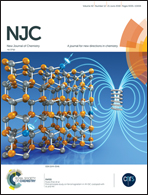Facile synthesis and fabrication of a poly(ortho-anthranilic acid) emeraldine salt thin film for solar cell applications
Abstract
Poly(o-anthranilic acid) emeraldine salt (PANA-ES) as a conjugated semiconductor polymer has been synthesized in an acidic medium based oxidative polymerization route. The identification of the PANA-ES powder has been carried out using the following techniques: FT-IR and UV-Vis. SEM has been used to investigate the morphology of the resulting PANA-ES powder. The structural properties of the resulting nanostructured PANA-ES thin film have been investigated by X-ray diffraction (XRD). The analysis of the spectral behavior characteristics of the nanostructured PANA-ES thin film, in the absorption region, displayed a direct and indirect allowed transition, and the fundamental energy gaps were estimated as (1.89, 3.24 eV) and (2.35, 4.06 eV), respectively. A hybrid (polymer/inorganic) heterojunction device built on PANA-ES (deposited by the spin coating technique onto a p-Si single crystal wafer) was fabricated. The dark I–V characteristics were determined at different temperatures in the range from 298 to 386 K of the Au/PANA-ES/p-Si/Al heterojunction diode. The device showed rectification behavior and an ideality factor of 85 at ±2 V and 3.229 determined at room temperature. Under the following different light intensities: 10.1, 15.3 and 20.5 W m−2, the Au/PANA-ES/p-Si/Al showed photovoltaic performance data with a short circuit current (Isc) and open circuit voltage (Voc) of (0.09 mA 1,41 mV), (0.16 mA, 176 mV) and (0.26 mA and 211 mV), respectively. The filling factor (FF) and electrical conversion efficiency (η) of the Au/n-PANA-ES/p-Si/Al device were found to be 0.205 and 6.07%, respectively.



 Please wait while we load your content...
Please wait while we load your content...